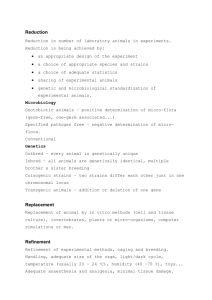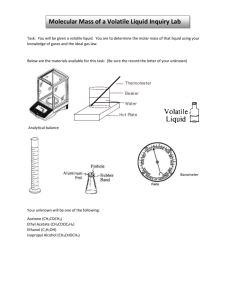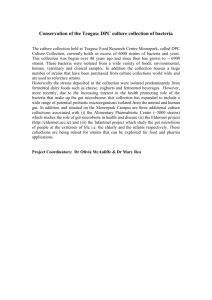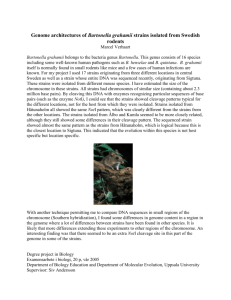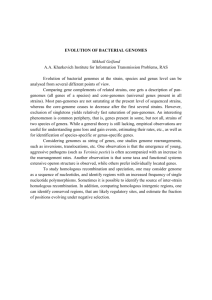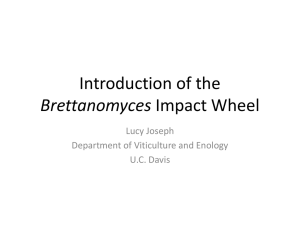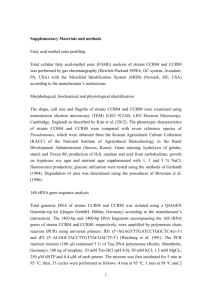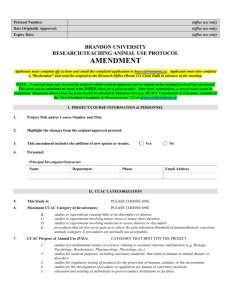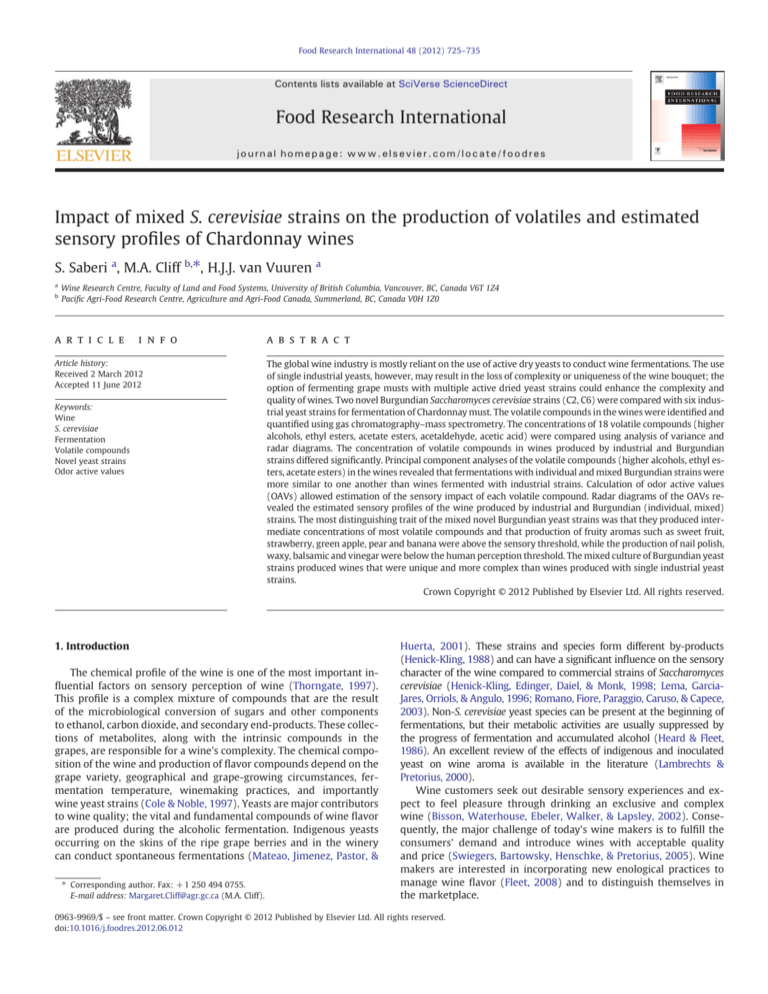
Food Research International 48 (2012) 725–735
Contents lists available at SciVerse ScienceDirect
Food Research International
journal homepage: www.elsevier.com/locate/foodres
Impact of mixed S. cerevisiae strains on the production of volatiles and estimated
sensory profiles of Chardonnay wines
S. Saberi a, M.A. Cliff b,⁎, H.J.J. van Vuuren a
a
b
Wine Research Centre, Faculty of Land and Food Systems, University of British Columbia, Vancouver, BC, Canada V6T 1Z4
Pacific Agri-Food Research Centre, Agriculture and Agri-Food Canada, Summerland, BC, Canada V0H 1Z0
a r t i c l e
i n f o
Article history:
Received 2 March 2012
Accepted 11 June 2012
Keywords:
Wine
S. cerevisiae
Fermentation
Volatile compounds
Novel yeast strains
Odor active values
a b s t r a c t
The global wine industry is mostly reliant on the use of active dry yeasts to conduct wine fermentations. The use
of single industrial yeasts, however, may result in the loss of complexity or uniqueness of the wine bouquet; the
option of fermenting grape musts with multiple active dried yeast strains could enhance the complexity and
quality of wines. Two novel Burgundian Saccharomyces cerevisiae strains (C2, C6) were compared with six industrial yeast strains for fermentation of Chardonnay must. The volatile compounds in the wines were identified and
quantified using gas chromatography–mass spectrometry. The concentrations of 18 volatile compounds (higher
alcohols, ethyl esters, acetate esters, acetaldehyde, acetic acid) were compared using analysis of variance and
radar diagrams. The concentration of volatile compounds in wines produced by industrial and Burgundian
strains differed significantly. Principal component analyses of the volatile compounds (higher alcohols, ethyl esters, acetate esters) in the wines revealed that fermentations with individual and mixed Burgundian strains were
more similar to one another than wines fermented with industrial strains. Calculation of odor active values
(OAVs) allowed estimation of the sensory impact of each volatile compound. Radar diagrams of the OAVs revealed the estimated sensory profiles of the wine produced by industrial and Burgundian (individual, mixed)
strains. The most distinguishing trait of the mixed novel Burgundian yeast strains was that they produced intermediate concentrations of most volatile compounds and that production of fruity aromas such as sweet fruit,
strawberry, green apple, pear and banana were above the sensory threshold, while the production of nail polish,
waxy, balsamic and vinegar were below the human perception threshold. The mixed culture of Burgundian yeast
strains produced wines that were unique and more complex than wines produced with single industrial yeast
strains.
Crown Copyright © 2012 Published by Elsevier Ltd. All rights reserved.
1. Introduction
The chemical profile of the wine is one of the most important influential factors on sensory perception of wine (Thorngate, 1997).
This profile is a complex mixture of compounds that are the result
of the microbiological conversion of sugars and other components
to ethanol, carbon dioxide, and secondary end-products. These collections of metabolites, along with the intrinsic compounds in the
grapes, are responsible for a wine's complexity. The chemical composition of the wine and production of flavor compounds depend on the
grape variety, geographical and grape-growing circumstances, fermentation temperature, winemaking practices, and importantly
wine yeast strains (Cole & Noble, 1997). Yeasts are major contributors
to wine quality; the vital and fundamental compounds of wine flavor
are produced during the alcoholic fermentation. Indigenous yeasts
occurring on the skins of the ripe grape berries and in the winery
can conduct spontaneous fermentations (Mateao, Jimenez, Pastor, &
⁎ Corresponding author. Fax: + 1 250 494 0755.
E-mail address: Margaret.Cliff@agr.gc.ca (M.A. Cliff).
Huerta, 2001). These strains and species form different by-products
(Henick-Kling, 1988) and can have a significant influence on the sensory
character of the wine compared to commercial strains of Saccharomyces
cerevisiae (Henick-Kling, Edinger, Daiel, & Monk, 1998; Lema, GarciaJares, Orriols, & Angulo, 1996; Romano, Fiore, Paraggio, Caruso, & Capece,
2003). Non-S. cerevisiae yeast species can be present at the beginning of
fermentations, but their metabolic activities are usually suppressed by
the progress of fermentation and accumulated alcohol (Heard & Fleet,
1986). An excellent review of the effects of indigenous and inoculated
yeast on wine aroma is available in the literature (Lambrechts &
Pretorius, 2000).
Wine customers seek out desirable sensory experiences and expect to feel pleasure through drinking an exclusive and complex
wine (Bisson, Waterhouse, Ebeler, Walker, & Lapsley, 2002). Consequently, the major challenge of today's wine makers is to fulfill the
consumers' demand and introduce wines with acceptable quality
and price (Swiegers, Bartowsky, Henschke, & Pretorius, 2005). Wine
makers are interested in incorporating new enological practices to
manage wine flavor (Fleet, 2008) and to distinguish themselves in
the marketplace.
0963-9969/$ – see front matter. Crown Copyright © 2012 Published by Elsevier Ltd. All rights reserved.
doi:10.1016/j.foodres.2012.06.012
726
S. Saberi et al. / Food Research International 48 (2012) 725–735
Single strains of commercial active dry wine yeasts have been used
for many years to control alcoholic fermentation; however, this has
resulted in the production of wines with a similar character throughout
the world. Nevertheless, winemakers have the ability to influence the
nature and complexity of their wine by utilizing new indigenous yeast
strains (Swiegers & Pretorius, 2005) or using mixtures of yeast strains
to develop complexity in their wines. Howell, Cozzolino, Bartowsky,
Fleet, and Henschke (2006) investigated the effects of mixed known
S. cerevisiae strains on the chemical profile and aromatic properties of
Chardonnay wines. They determined that the chemical profiles of the
wines fermented with individual and mixed S. cerevisiae strains were
different and that it was not possible to blend wines produced by the
single strains to create the same chemical profile as a wine fermented
by the mixed yeast cultures.
To characterize the chemical profile of a wine, the compounds
must be first extracted and/or concentrated prior to gas chromatography (GC) or GC–mass spectroscopy (MS). This can be accomplished
using a number of techniques including: static headspace, purge
and trap, solid-phase microextraction (SPME), as well as solvent-,
supercritical-, microwave- and stir bar sorption–extraction methods
(Malherbe, Watts, Nieuwoudt, Bauer, & du Toit, 2009). Since these
techniques influence the presence and concentration of the metabolites, they in part explain the differences in compounds reported in
the literature.
Patel and Shibamoto (2003) used solvent extraction and GC–FID
to quantify 53 volatile compounds from 20 yeasts of S. cerevisiae in
Symphony wine. While 18 of the 20 yeast strains produced the
same compounds (alcohols, esters, acids), it was the difference in
concentration of these compounds which influenced the flavor profile
of the wine. In contrast, Li, Tao, Wang, and Zhang (2008) utilized
SPME GC–MS to quantify 41 compounds in Chardonnay, of which
13 were odor active. Like Komthong, Hayakawa, Katoh, Igura, and
Shimoda (2006), they used odor active values (OAVs) to evaluate
the sensory impact of the volatile compounds. Malherbe et al.
(2009), used headspace SPME GC–MS to identify 68 volatile compounds in red and white wine and were able discriminate between
control and problematic fermentations.
As such, headspace analysis was applied in this research to more
thoroughly understand the volatiles among Chardonnay wines fermented with individual and mixed yeast cultures, compared to six
commercial yeast strains. This research was undertaken to: i) first document the uniqueness of two novel Burgundian yeast isolates, ii) quantify the volatile profiles of wines from these novel Burgundian strains
when fermented as individual and mixed cultures and iii) estimate the
sensory profile of the resultant wines using OAVs and radar diagrams.
Yeast Australia (Sydney, NSW, Australia), CY3079 and ICV-D254 by
Lallemand (Montreal, QC, Canada) and one (X16) by Laffort (Petaluma, CA, USA); all were purchased from Scott Laboratories (Pickering,
ON, Canada) as active dry yeasts. These strains were recommended
for white wines especially Chardonnay to increase fruity aroma and
complexity (AB Mauri, 2012; Laffort, 2009; Lallemand, 2012). Yeasts
were cultured in Difco yeast peptone dextrose (YPD) broth (Becton,
Dickinson and Co., Sparks, MD, USA) based on the standard methods
(Ausubel et al., 1995). S. cerevisiae strains were stored at − 80 °C in
YPD broth with 15% glycerol.
Individual yeast strains were genetically fingerprinted by a polymerase chain reaction (PCR) method. The PCR method discriminated yeast
strains based on the amplification of repetitive δ sequences of S. cerevisiae
genome (Saberi, 2011; Schuller, Valero, Dequin, & Casal, 2004), which are
often associated with Ty1 transposons (Schuller et al., 2004). The
PCR was performed on a MJ Research Peltier Thermal Cycler 200
(Walthman, USA) using the δ 2 (5′-GTGGATTTTTATTCCAAC-3′) and
δ 12 (5′-TCAACAATGGAATCCCAAC-3′) primers.
Freezer stocks of S. cerevisiae strains were used to inoculate 5 mL
liquid cultures of YPD; S. cerevisiae cells were grown overnight in a rotary wheel to stationary phase at 30 °C. Flasks containing 50 mL YPD
cultures were subsequently inoculated for each strain at a rate of
5 × 10 5 cells/mL and grown aerobically in a shaker bath (180 rpm) at
30 °C for 24 h. Cells were then harvested by centrifugation (5000 g
for 5 min). Harvested cells were washed with sterile MilliQ water
and re-suspended in the fermentation medium (Saberi, 2011).
2.3. Fermentations
Chardonnay fermentations were performed in triplicate at 16 °C and
20 °C; these temperatures reflect commercial winemaking conditions
that optimize retention of volatiles and reflect typical cellar conditions,
respectively. The 250 mL fermentation bottles containing 200 mL Chardonnay must were inoculated at the rate of 2 × 106 cells/mL. Mixed
strain fermentations were inoculated using the ratios as indicated
above (M1, M2, M3, M4). Yeast strains were not mixed before inoculation. All fermentation bottles were topped with disinfected (70% ethanol) rubber bungs and water-filled capped gas locks to provide
anaerobic conditions. When fermentations were complete, 100 mg/L
of potassium metabisulflite was added to prevent oxidation. Anaerobic
sampling was aseptically performed by removing approximately 1 mL
sample through the rubber bung with a 12.5 cm hypodermic needle
(Air-Tite, Virginia Beach, VA, USA) attached to a 3 mL syringe (Becton
Dickinson, Franklin Lakes, NJ, USA). Fifty mL wine samples were placed
in 50 mL glass vials with screw cap closures, and stored at 4 °C for
3–4 weeks until GC analysis.
2. Materials and methods
2.4. Headspace analysis by gas chromatography–mass spectroscopy
2.1. Juice
Chardonnay must was obtained from White Salmon Vineyard in
California (2008). It had soluble solids (SS), pH, titratable acidity
(TA) and yeast available nitrogen (YAN) of 24 °Brix, 3.46, 5.76 g/L
and 131 mg nitrogen/L, respectively. The juice was stored at −20 °C
prior to use.
2.2. Yeast strains and yeast culturing
The novel S. cerevisiae yeast strains were isolated from a vineyard
in Burgundy region, France and named C2 and C6. To evaluate the impact of mixed fermentations on the complexity of the wine, these
strains (C2:C6) were mixed in four ratios 1:1, 1:2, 1:3 and 2:3, referred to as M1, M2, M3 and M4, respectively. The individual and
mixed strains were compared to six widely used commercially available yeast strains of S. cerevisiae (Blanc, Elegance, Fusion, CY3079,
ICV-D254, X16). Blanc, Elegance, Fusion were produced by Mauri
Headspace analysis of the volatile compounds in the Chardonnay
wines was conducted by gas chromatography–mass spectrometry
(GC–MS) analysis, according to the method utilized by Danzer,
Garcia, Thiel, and Reichenbacher (1999). Other technologies are available for volatile analysis, such as solid phase microextraction (SPME);
this methodology adsorbs the volatiles onto a fiber prior to GC analysis. While this concentrates the volatiles and enhances sensitivity, it
also shifts the pattern of volatiles to those that are preferentially
adsorbed by the fiber. In contrast headspace analysis samples the volatiles directly from the gas phase above the wine, which more closely
resembles the collection or pattern of volatiles that would be evaluated by a human assessor.
Wine samples (10 mL) were sterile filtered (0.22 μm) and placed
in 20 mL glass GC headspace vials with 3 g of NaCl. Vials were sealed
with rubber septa and metal crimp tops. Vials were agitated, then
equilibrated at 85 °C for 10 min, prior to injecting 1 ml of headspace
sample into the GC–MS (Agilent Technologies, Palo Alto, USA).
S. Saberi et al. / Food Research International 48 (2012) 725–735
The GC was equipped with a 60 m × 0.25 mm ID, 0.25 μm thickness DBWAX fused silica open tubular column (J&W Scientific,
Folstom, CA, USA) and 5973N Mass Selective Detector (MSD) (Agilent
Technologies, Wilmington, DE, USA) for separation, detection and
quantification of volatile compounds. Ultra high purity helium was
used at a flow rate of 1.3 mL/min. The headspace samples (1 mL)
were injected through a valve that was maintained at 100 °C, while
the temperature of the transfer line was kept at 110 °C. The initial
temperature of the GC oven was held at 40 °C for 5 min, raised to
100 °C at a rate of 5 °C/min, then increased to 200 °C at a rate of
20 °C/min. The MSD was set in scan mode with a mass range of 35–
400 amu. Each sample was quantified in triplicate; 3-octanol was
used as an internal standard.
2.5. Volatile selection and quantification
Volatile compounds were identified by GC–MS using the enhanced
Chemstation software (Chemstation Build 75, Agilent Technologies,
Palo Alto, CA, USA). Aroma compounds were identified by comparing
the peak retention times against those of authentic standards and
matching the mass spectra against the Wiley7Nist05 mass library
(Wiley & Sons, Hoboken, NJ, USA). Peaks were quantified when the
signal-to-noise ratio was greater than 10. The single point internal
standard method (Alltech Associates, 1998) was used to quantify the
headspace concentration of the volatiles, by comparing their responses to that of the internal standard (IS). Standards were prepared
in a synthetic wine (~12% ethanol + tartaric acid, pH ~ 2.3) with 3octanol as an IS. The formula used for quantifying the specific volatiles
(SV) was: concentration of SV = (concentrationIS × areaSV × IRFSV) /
areaIS, where IRF was the internal response factor.
727
strains. A group mean for the industrial strains was not calculated, since
the commercial strains were not similar to one another.
Since the radar option did not have provision for different scales, it
was necessary to multiply the concentrations of the compounds by a
constant (0.05–200). This meant radar plots of the volatiles represented relative values; exact concentrations for the higher alcohol,
ethyl esters, and acetate esters can be obtained from Tables 2, 3 and
4 respectively. The relative sensory impact of the volatile compounds
was represented using odor active values (OAVs), for the 18 volatile
compounds. OAVs were calculated by dividing the volatile concentration by the absolute aroma threshold (mg/L). Since wine thresholds
were not available for most compounds, published water thresholds
(Campo, Ferreira, Escudero, Marques, & Cacho, 2005; Culleré, Escudero,
Cacho, & Ferreira, 2004; Francis & Newton, 2005; Schieberle &
Hofmann, 1997) were utilized, as is customary in the literature (Li, Tao,
Wang, & Zhang, 2008).
Radar plots of the OAVs were constructed using a log scale; this
allowed widely different concentrations (1 × 10 − 4–1 × 10 3 mg/L) to
be represented on the same figure. These estimated sensory profiles
were labeled with the sensory attribute typically associated with
the volatile as well as the volatile abbreviation (Table 1).
In order to compare the individual and mixed Burgundian strains
with all the commercial yeasts, it was necessary to generate three
plots, each with two commercial yeast strains. In addition, the odor
and estimated sensory profiles were placed on the same page, so
that the diagrams could be readily compared.
ANOVA and radar plots were calculated using MS Excel (Seattle,
WA, USA); whereas, PCA and cluster analyses were performed using
Minitab 15 (State College, PA, USA).
2.6. Statistical analysis
3. Results
A two-factor analysis of variance (ANOVA) with replication was
used to evaluate the effects of yeast strains, temperature as well as
their interaction (temperature× yeast) on the production of volatile
compounds. Since the effects of temperature and temperature× yeast
were none significant (p> 0.05) for all compounds, only the effect of
yeast strain was reported, i.e. mean values were averaged across both
fermentation temperatures. Differences among yeast strains were evaluated using Fisher's least significant difference (LSD) test (p≤ 0.05).
Principal component analysis (PCA) using the correlation matrix
was conducted on mean volatile concentrations for the six individual
industrial, two individual Burgundian, and four mixed Burgundian
strains. PCA assessed the volatile profile among the yeast strains.
PCA analyses were performed on all volatiles, as well as the collection
of higher alcohols, ethyl esters and acetate esters. Volatile compounds
were represented as vectors. Principal component (PC) I, PC II and PC
III were calculated and bivariate plots prepared for PC I versus PC II,
PC II versus PC III and PC I versus PC III. However, in the interests of
brevity, only PC I versus PC II were reported in this manuscript. However, the other plots were examined to verify that the interrelationships among the strains were retained in these higher dimensions
(PC I versus PC III, PC II versus PC III). For clarity of presentation, vector coordinates were scaled by a factor of three times compared to the
sample coordinates.
Radar diagrams (MS Excel, Seattle, WA, USA) were used to represent
the odor profiles, as well as the estimated sensory profiles for the 18
volatile compounds. These profiles were created using mean volatile
concentrations (mg/L) and odor active values (OAVs), respectively.
Group means for the individual Burgundian strains (n= 12, 2 yeasts× 3
replications× 2 temperatures) and mixed Burgundian strains (n= 24, 4
yeast mixtures× 3 replications× 2 temperature) were compared to the
industrial yeast strains (n= 6, 1 yeast × 3 replications × 2 temperatures), using a collection of three plots. Each diagram compared the individual Burgundian and mixed Burgundian strains with two industrial
3.1. Genetic characterization of yeast strains
Genetic fingerprinting successfully differentiated two Burgundian
strains (C2, C6) and six industrial strains based on their differences in
the chromosomal regions between δ sequences. The PCR method discriminated yeast strains based on the amplification of the δ fragments
in the S. cerevisiae genome. The individual Burgundian strains C2 and
C6 shared four common bands around 350, 450, 750 and 1000 bp; C6
had an additional band around 250 bp, which distinguished it from C2
(data not shown) (Saberi, 2011).
Table 1
Quantifiable volatile compounds in Chardonnay wine fermented by six individual industrial, two individual Burgundian and four mixed Burgundian S. cerevisiae strain at
16 °C and 20 °C. The quantifiable compounds were listed by their class.
Volatile compound
Class/Abbreviation
2,3-Butanediol
2-Methyl-1-butanol
3-Methyl-1-butanol
n-Butanol
1-Hexanol
Isobutanol
Phenylethanol
Propanol
Ethyl butanoate
Ethyl hexanoate
Ethyl octanoate
Ethyl decanoate
Ethyl laurate
Ethyl acetate
Isoamyl acetate
Hexyl acetate
Acetaldehyde
Acetic acid
Higher alcohol (HA-1)
Higher alcohol (HA-2)
Higher alcohol (HA-3)
Higher alcohol (HA-4)
Higher alcohol (HA-5)
Higher alcohol (HA-6)
Higher alcohol (HA-7)
Higher alcohol (HA-8)
Ethyl ester (EE-1)
Ethyl ester (EE-2)
Ethyl ester (EE-3)
Ethyl ester (EE-4)
Ethyl ester (EE-5)
Acetate ester (AE-1)
Acetate ester (AE-2)
Acetate ester (AE-3)
Aldehyde (ACET)
Acid (AA)
728
S. Saberi et al. / Food Research International 48 (2012) 725–735
3.2. Production of volatile compounds by wine yeast strains
Eighteen compounds were quantifiable (Table 1) in the headspace
of the wines. These included eight higher alcohols, five ethyl esters,
three acetate esters, one aldehyde and one organic acid. The concentration of higher alcohols, ethyl esters and acetate esters for the industrial, individual Burgundian and mixed Burgundian strains are
reported in Tables 2, 3 and 4 respectively. In general, the concentration
of the volatile compounds for the individual and mixed Burgundian
strains was mid-range or intermediate, compared to the industrial
yeasts. This was exemplified by the concentrations observed for
3-methyl-1-butanol for the individual Burgundian (7.007–7.190 mg/L)
and mixed Burgundian (6.188–7.453 mg/L) yeasts compared to the industrial yeast (5.789–9.292 mg/L). This pattern was observed for all of
the compounds, across all classes, with the exception of 2,3-butanediol
produced by M4, which was the lowest of the reported concentrations.
Two additional compounds (acetaldehyde, acetic acid) followed a
similar pattern (data not shown), as described above, with the exception
of acetaldehyde concentrations produced by M3 (1.422 mg/L), which
were at the high end of the range associated with the industrial strains
(0.732 mg/L – 1.422 mg/L). Mixed Burgundian yeast strains produced
higher concentrations of higher alcohols such as 2-methyl-1-butanol
and lower concentrations of the higher alcohols 2,3-butanediol, propanol
and phenylethanol. The Burgundian yeast strains also produced more
ethyl hexanoate and ethyl octanoate, and low to moderate concentrations of the acetate esters compared to industrial strains. In contrast,
most of the industrial strains produced either very low or very high concentrations of acetate esters.
Table 3
Mean concentrations1 (mg/L) of ethyl esters in Chardonnay wines fermented with six
individual industrial yeast strains, two individual Burgundian and four mixed Burgundian yeasts trains, averaged across two fermentation temperatures (n = 6). Yeast strain
effect2 is shown for each volatile compound.
Yeast strain
Ethyl
butanoate
Ethyl
hexanoate
Ethyl
octanoate
Ethyl
decanoate
Ethyl
laurate
0.036ab
0.045ab
0.059b
0.042ab
0.030a
0.039ab
0.035a
0.048bc
0.059c
0.045bc
0.030a
0.036ab
0.028ef
0.031fg
0.034g
0.025de
0.022abcd
0.024cde
0.001a
0.005d
0.010e
0.003bc
0.002ab
0.004cd
Individual Burgundian strains
C2
0.211a
0.043ab
C6
0.229abc
0.044ab
0.040ab
0.040ab
0.017a
0.020abcd
0.002ab
0.002ab
0.041ab
0.042ab
0.023bcde
0.001a
0.040ab
0.042ab
0.025de
0.002ab
0.040ab
0.040ab
0.022abcd
0.002ab
0.042ab
0.041ab
0.018ab
0.001a
Individual industrial strains
Blanc
0.200a
Elegance
0.275cd
Fusion
0.299d
CY3079
0.299d
ICV-D254
0.361e
X16
0.268bcd
Mixed Burgundian strains
(C2/C6:1/1), 0.246abcd
M1
(C2/C6:1/2), 0.217ab
M2
(C2/C6:1/3), 0.218ab
M3
(C2/C6:3/2), 0.215a
M4
Range
0.200–0.361
0.030–0.059 0.030–0.059 0.017–0.034 0.001–0.01
1
The mean values of the biological replicates of each yeast strain at two temperatures are shown (n = 6).
2
Yeast strain means with different letters are significantly (p ≤ 0.05) different.
3.3. Principal component analyses of the wine yeast strains
Principal component analyses (PCA) of the higher alcohols, ethyl esters and acetate esters in the Chardonnay wines are shown in Fig. 1A-C,
respectively. PCA of the higher alcohols (Fig. 1A) accounted for 65.6% of
the total variability in the data, with 37% and 28.6% of the variance
explained by the PC I and PC II, respectively. The industrial strains
were scattered throughout the plot, reflecting extremely different patterns of production of higher alcohols. This was consistent with concentrations reported in Table 2. Three yeast strains (Fusion, Elegance and
CY3079) were positioned slightly above CY3079 and C2 (Fig. 1A),
reflecting much higher concentrations of 3-butanediol (HA-1), hexanol
(HA-5), phenylethanol (HA-7) and propanol (HA-8). The X16 and Blanc
strains had very dissimilar patterns of higher alcohol production compared to all other strains, as shown by their locations, to the far right
and far left of the plot, respectively (Fig. 1A). The mixed Burgundian
strains composed a distinct group, with the exception of M4, which
was most heavily loaded on negative PC II (Fig. 1A). M4 had lower concentrations of 2,3-butanediol (HA-1) and higher concentrations of HA6. In contrast, the mixed Burgundian strains and C6 had relatively high
concentrations of 2-methyl-1-butanol (HA-2), n-butanol (HA-4) and
isobutanol (HA-6) and lower concentrations of 2,3-butanediol (HA-1),
n-butanol (HA-4) and propanol (HA-8) (Fig. 1A). This was consistent
with concentrations reported in Table 2. The mixed Burgundian strains
produced moderate amounts of the higher alcohols compared to X16
Table 2
Mean concentrations1 (mg/L) of higher alcohols in Chardonnay wines fermented with six individual industrial yeast strains, two individual Burgundian and four mixed Burgundian
yeast strains, averaged across two fermentation temperatures (n = 6). Strain effect2 is shown for each volatile compound.
Yeast strain
2-Methyl-1-butanol
3-Methyl-1-butanol
n-Butanol
1-Hexanol
Isobutanol
Phenylethanol
Propanol
strains
1.235jk
1.065ghi
1.223ijk
1.110hij
0.864bcdef
1.326k
1.150a
1.170a
1.420def
1.181ab
1.249abcd
1.763f
5.789a
7.167defg
7.056cdefg
6.723abcdefg
6.609abcdefg
9.292h
0.049bc
0.046bc
0.056cd
0.033a
0.101e
0.047bc
1.918de
1.949ef
2.212h
1.899cdef
1.811bcdef
1.603a
6.666a
9.744b
7.400a
12.829f
11.825cdef
15.259i
0.906cdef
1.254j
1.242ij
1.070h
0.879bcde
1.658k
5.034k
2.713j
2.111hi
1.427a
1.614abc
2.015fghi
Individual Burgundian strains
C2
1.063ghi
C6
0.942defgh
1.375cd
1.291abcd
7.190efg
7.007bcdefg
0.072d
0.039ab
1.993g
1.964fg
11.999def
19.183k
1.023fgh
1.056gh
2.136i
1.941defgh
Mixed Burgundian strains
(C2/C6:1/1), M1
0.975efgh
(C2/C6:1/2), M2
0.920cdefg
(C2/C6:1/3), M3
0.990fgh
(C2/C6:3/2), M4
0.545a
Range
0.545–1.326
1.375cd
1.349bcd
1.572ef
1.291abcd
1.150–1.763
6.188abcdef
7.203fg
7.453g
6.740abcdefg
5.789–9.292
0.056cd
0.056cd
0.054bc
0.053bc
0.033–0.101
1.904cdef
1.809bcdef
1.960fg
1.716ab
1.603–2.212
14.892hi
14.744ghi
17.327j
12.781ef
6.666–19.183
1.070h
0.933efg
0.916def
0.474a
0.474–1.658
2.019ghi
1.786cde
1.960efghi
1.664bc
1.427–5.034
Individual industrial
Blanc
Elegance
Fusion
CY3079
ICV-D254
X16
1
2
2,3-Butanediol
The mean values of the biological replicates of each yeast strain at two temperatures are shown (n = 6).
Yeast strain means with different letters are significantly (p ≤ 0.05) different.
S. Saberi et al. / Food Research International 48 (2012) 725–735
Table 4
Mean concentrations1 (mg/L) of acetate esters in Chardonnay wines fermented with
six individual industrial strains, two individual Burgundian and four mixed Burgundian
yeast strains, averaged across two fermentation temperatures (n = 6). Yeast strain effect2 is shown for each volatile compound.
Yeast strain
Ethyl acetate
Hexyl acetate
Isoamyl acetate
Individual industrial strains
Blanc
7.761ij
Elegance
6.954hi
Fusion
5.703a
CY3079
6.635cdefgh
ICV-D254
6.245abcdefgh
X16
8.448j
0.024bcde
0.027ef
0.019a
0.030f
0.024bcde
0.035g
0.093defgh
0.109hij
0.059a
0.118j
0.107ghij
0.220k
Individual Burgundian strains
C2
6.617bcdefgh
C6
6.663defgh
0.024bcde
0.024bcde
0.090cdefgh
0.116ij
Mixed Burgundian strains
(C2/C6:1/1), M1
6.554abcdefgh
(C2/C6:1/2), M2
6.756efgh
(C2/C6:1/3), M3
6.917ghi
(C2/C6:3/2), M4
6.809fgh
Range
5.703–8.448
0.025cde
0.027ef
0.024bcde
0.026de
0.019–0.030
0.100efghij
0.109hij
0.104fghij
0.085bcdef
0.059–0.118
1
The mean values of the replicates of each yeast strain at two temperatures are
shown (n = 6).
2
Yeast strain means with different letters are significantly (p ≤ 0.05) different.
and Blanc as shown in Table 2. In general, the mixed Burgundian strains
were more similar to one another than to the industrial strains, with the
exception of ICV-D254.
PCA of the ethyl esters (Fig. 1B) production in the Chardonnay
wines described 88.3% of the total variability in the data, with 65%
and 23.3% explained by PC I and PC II, respectively. The industrial
strains were located throughout the plot, reflecting the very different
patterns of ethyl ester production; Fusion and ICV-D254 yeast strains
were most different (Fig. 1B). In contrast, the individual and mixed
Burgundian strains were grouped together in the center of the plot,
with the industrial strain Blanc being most similar to the Burgundian
strains, as reflected by their close proximity (Fig. 1B). The other three
industrial strains (X16, CY3079, Elegance) were positioned slightly
above the PCA center (Fig. 1B) and had similar ethyl ester profiles
to one another. The individual and mixed Burgundian strains produced higher concentrations of ethyl hexanoate (EE-2) and ethyl
octanoate (EE-3). In contrast, the Burgundian strains produced
lower concentrations of ethyl butanoate (EE-1), while most of the
industrial strains produced higher concentrations of ethyl butanoate,
as shown in Table 3. Clearly, the individual and mixed Burgundian
strains were more similar to one another than to the industrial
strains, with the exception of Blanc.
PCA plot of acetate esters (Fig. 1C) accounted for 97.2% of the total
variability in the data, with 85.8% and 10.4% of the variance explained
by PC I and PC II, respectively. The individual and mixed Burgundian
yeasts were grouped together forming overlapping clusters in the
centre of the plot, reflecting similar patterns of acetate production.
Slightly outside this grouping was ICV-D254, Elegance and CY3079,
indicating that these yeasts had very different concentrations of
ethyl acetates. In contrast, the industrial strains X16 and Fusion
were positioned to the far right and far left, respectively, reflecting
extremely different acetate ester profiles. X16 produced higher concentrations of hexyl acetate (AE-2) and isoamyl acetate (AE-3); consistent with acetate ester concentrations reported in Table 4. In
contrast, Fusion produced lower concentrations of both these compounds compared to the Burgundian strains.
When comparing Fig. 1A-C, it is evident that the commercial
yeasts were more similar to the Burgundian yeasts in production of
acetate esters (Fig. 1C) than they were for production of higher alcohols (Fig. 1A) or ethyl esters (Fig. 1B).
729
PCA of all the volatile compounds (Fig. 1D) accounted for 56.1% of
the total variability in the data, with 29.4% and 26.7% of the variance
explained by PC I and PC II, respectively. The individual and mixed
Burgundian strains composed a grouping in the center of PCA plot,
with the exception of M4. It had higher concentrations of n-butanol
(HA-5) and isobutanol (HA-6) (Table 2). In contrast, the industrial
strains were scattered throughout the plot, indicative of yeasts with
very different overall volatile profiles. The industrial strain ICV-D254
was the most similar to M4; whereas, the industrial strain Blanc
was most similar to the Burgundian strains and M1. Interestingly,
the mixed Burgundian strain M1 (1:1 ratio of C2:C6) was located in
the plot between the two individual Burgundian strains C2 and C6.
In contrast, X16 and Fusion were most dissimilar to the other yeast
strains (Fig. 1D), as reflected by their location on the plot, with high
concentrations of 3-methyl-1-butanol (HA-3), isobutanol (HA-6),
and hexyl acetate (EA-3) and acetaldehyde (ACET) and acetic acid
(AA), respectively (Tables 2–4).
3.4. Odor profiles, OAVs and estimated sensory profiles of the Chardonnay wines
Table 5 summarizes the volatile compounds, aroma descriptors,
water thresholds (Campo et al., 2005; Culleré et al., 2004; Francis &
Newton, 2005; Schieberle & Hofmann, 1997) and odor active values
(OAVs) for the individual and mixed Burgundian strains. OAVs greater than one, less than one reflect concentrations that are above and
Table 5
Odor thresholds and odor active values (OAVs) of individual volatile compounds calculated by dividing the mean odor concentration for the yeast groups by the odorant
threshold (mg/L). The odorant concentrations (mg/L) were determined by GC–MS
and averaged between two fermentation temperatures for individual Burgundian
yeasts (n = 12) and mixed Burgundian yeasts (n = 24).
Compound
Aroma
descriptor
Higher alcohols
2,3-Butanediol
2-Methyl-1-butanol
3-Methyl-1-butanol
n-Butanol
1-Hexanol
Isobutanol
Phenylethanol
Propanol
Creamyb
Sweet fruitc
Berryd
Nail polishd
Grassb
Fuselb
Roseb
Candyd
Ethyl esters
Ethyl butanoate
Ethyl hexanoate
Ethyl octanoate
Ethyl decanoate
Ethyl laurate
Strawberryc
Green applec
Peard
Dried fruitc
Waxyd
Acetate esters
Ethyl acetate
Hexyl acetate
Isoamyl acetate
Balsamicc
Appleb
Bananab
Aldehyde
Acetaldehyde
Overripe appleb
Organic acids
Acetic acid
Vinegard
a
Odor
threshold
(mg/L)
150b
0.42c
30d
150d
8b
40b
14b
306e
0.02c
0.14c
0.005c
0.2b
0.5d
Mean odor active valuea
Individual
Burgundian
0.007
3.169
0.237
0.0004
0.247
0.390
0.074
0.007
Mixed
Burgundian
0.006
3.322
0.230
0.0004
0.231
0.373
0.061
0.006
11.001
3.130
8.005
0.092
0.004
11.200
2.914
8.215
0.110
0.004
12c
1.5b
0.03b
0.553
0.016
3.432
0.563
0.017
3.312
0.5b
1.998
2.307
b 0.0001
b 0.0001
600d
Odor active values (OAVs) obtained by dividing the mean concentration of the volatile for the yeast group, by the published absolute threshold in water. Individual Burgundian yeasts (n = 12); 2 yeasts × 2 temperatures × 3 replications. Mixed Burgundian
yeasts (n = 24); 4 yeasts × 2 temperatures × 3 replications.
b
Campo et al. (2005).
c
Francis and Newton (2005).
d
Culleré et al. (2004).
e
Schieberle and Hofmann (1997).
730
S. Saberi et al. / Food Research International 48 (2012) 725–735
Fig. 1. Principal component analyses plots of mean values for higher alcohols (A), ethyl esters (B), acetate esters (C) and all volatile compounds (D) averaged across two fermentation temperatures. Wine fermentations from the individual Burgundian strains and mixed Burgundian strains are shown with red and green ellipses, respectively. Volatile compounds for the higher alcohol (HA-1–HA-8), ethyl esters (EE-1–EE-5) and acetate ester (AE-1–AE-3) are listed in Table 1. (Vector coordinates = 3 × sample coordinates.)
below their sensory thresholds, respectively. Interestingly, the OAVs
for the higher alcohols for the individual and mixed Burgundian
strains (Table 5) were all less than one, except for 2-methyl-1-butanol, suggesting that these volatiles were non-perceptible. In contrast,
the OAVs of the three ethyl esters (ethyl butanoate, ethyl hexanoate,
ethyl octanoate) were greater than one, indicating that these compounds were perceptible.
The OAVs for isoamyl acetate and acetaldehyde were also greater
than one and the OAV for acetic acid was less than one, reflecting
that these compounds were present above and below threshold, respectively. In fact, the OAVs for the individual and mixed Burgundian
strain were very similar, suggesting that their estimated sensory profiles would also be alike. This was not the case for the commercial
strains.
Odor profiles (Figs. 2A, 3A, 4A) for the individual and mixed
Burgundian strains were compared to the commercial yeasts in
three plots, each containing two commercial yeasts [Fig. 2A (Fusion,
Blanc); Fig. 3A (X16, ICV-D254); Fig. 4A (Elegance, CY3079)]. These
radar diagrams provide a simple graphical representation of the relative
volatile concentrations. Exact concentrations for the higher alcohols,
ethyl esters and acetate esters can be obtained from Tables 2, 3 and 4,
respectively. In these diagrams, the individual and mixed Burgundian
strains are more similar to one another than to the industrial strains. Interestingly, the mixed Burgundian strains produce slightly more acetaldehyde and slightly less 2,3-butanediol than individual Burgundian
strains.
The odor profile of the industrial strain Fusion was considerably different from the Burgundian strains. Fusion produced slightly higher
concentrations of higher alcohols (2,3-butanediol,1-hexanol, phenyl
ethanol), as well as higher concentrations of ethyl esters (ethyl butanoate, ethyl hexanoate, ethyl laurate). In contrast, the Burgundian
strains produced higher concentrations of acetate esters, specifically
isoamyl acetate.
The acetic acid production of Fusion was slightly higher than Burgundian strains (Fig. 2A). The Blanc industrial strain produced higher
concentrations of propanol, 2,3-butanediol, ethyl decanoate and acetaldehyde than Burgundian strains (Fig. 2A); the Burgundian strains had
slightly higher levels of acetic acid compared to that produced by
Blanc (Fig. 2A). While the concentration was elevated and the volatile
had an OAV less than one (Table 5), acetic acid was in fact below the
sensory threshold and would not represent a problem enologically.
Although industrial strains had concentrations of one or more volatile compounds, which were similar to the Burgundian strains, no
single industrial strain provided an identical profile. This suggested
that the volatile profile of the Burgundian strains were indeed unique.
3.5. Estimated sensory profiles of the Chardonnay wines
While the odor profiles (Figs. 2A, 3A, 4A) summarized the volatile
compounds among the yeasts, the estimated sensory profiles
(Figs. 2B, 3B, 4B) summarized the expected aromatic profiles. These
radar diagrams illustrated the overall sensory relevance (estimated)
of the volatiles and allowed for a simple graphical comparison of
the yeasts. Values (log OAV) greater than zero and less than zero represented volatiles that were above and below the human threshold,
respectively.
The estimated sensory profiles of the individual and mixed
Burgundian strains were most similar to one another than the commercial strains. The commercial strains Blanc and X16 were similar, with
Blanc wines having less waxy and more candy-like aromas (Fig. 2B). Although the Burgundian strains produced more berry, fusel oil, candy
and balsamic aromas, all of these aromas were below the human perception threshold (Fig. 2B).
The Burgundian strains produced lower levels of nail polish (HA-4)
and vinegar (AA) aromas than the industrial strains, while the industrial
strains produced more strawberry (EE-1), green apple (EE-2), pear (EE-3)
S. Saberi et al. / Food Research International 48 (2012) 725–735
731
Fig. 2. Odor profile (A) of the 18 volatile compounds in Chardonnay wines. Mean volatile concentrations (mg/L) for individual Burgundian (n = 12), mixed Burgundian strains
(n = 24) and individual industrial strains (Blanc, Fusion) (n = 6), averaged across both fermentation temperatures as listed in Table 2. Estimated sensory profile (B) expressed
as the log of the odor active values (OAV) for the 18 volatile compounds in Chardonnay wines. (OAV = concentration / threshold.)
and waxy (EE-5) aromas. However, the Burgundian strains did have fruity
(sweet fruit, strawberry, green apple, pear, banana) aromas that were
above their sensory thresholds (Fig. 2B), with OAVs greater than one
(Fig. 2A).
The X16 strain produced higher concentrations of ethyl butanoate,
acetate esters and acetic acid than the Burgundian strains. The Blanc
strain produced more ethyl butanoate but less ethyl hexanoate than
the Burgundian strains (Fig. 3A). The industrial strains X16 and ICVD254 showed very similar estimated sensory profiles (Fig. 3B).
These industrial strains produced less berry, fusel oil and candy
aromas but more nail polish, strawberry, green apple, pear, waxy, banana and vinegar aromas than Burgundian strains (Fig. 3B).
Fig. 4B compared the Burgundian strains with the two other industrial
strains (Elegance, CY3079). These industrial strains had similar estimated
sensory profiles to the other industrial strains, producing less berry, fusel
oil, candy, and balsamic aromas, but more nail polish, ethyl ester fruity
and waxy and vinegars aromas compared to the Burgundian strains
(Fig. 4B).
In general, the estimated sensory profiles of the individual and
mixed Burgundian strains revealed that production of fruity
aromas such as sweet fruit, strawberry, green apple, pear and banana were above their sensory threshold, while the production of
nail polish, waxy, balsamic and vinegar were below their human
perception threshold.
732
S. Saberi et al. / Food Research International 48 (2012) 725–735
Fig. 3. Odor profile (A) of the 18 volatile compounds in Chardonnay wines. Mean volatile concentrations (mg/L) for individual Burgundian (n = 12), mixed Burgundian strains
(n = 24) and individual industrial strains (X16, ICV-D254) (n = 6), averaged across both fermentation temperatures as listed in Table 3. Estimated sensory profile (B) expressed
as the log of the odor active values (OAV) for the 18 volatile compounds in Chardonnay wines. (OAV = concentration/threshold.)
4. Discussion
Chardonnay wines fermented by individual Burgundian and
mixed Burgundian strains had more similar levels of volatile compounds (higher alcohols, ethyl esters, acetate esters), than those produced by the commercial yeasts. While relatively low concentrations
of higher alcohols contribute fruity-like aromas; at higher concentrations (>300 mg/L) (Swiegers et al., 2005) they contribute ‘hot’ and
‘irritating’ aromas, which are undesirable to the consumer. In this research, the Burgundian mixtures produced moderate levels of these
higher alcohols. Previous studies (Ough & Amerine, 1967) have
reported that the concentrations of some higher alcohols tend to increase with fermentation temperature; this was not observed in this
research between fermentations of 16 and 20 °C.
Principal component analysis (PCA) of the three classes of volatiles successfully grouped the Burgundian yeasts and differentiated
them from the industrial strains for higher alcohols, ethyl esters and
acetate esters production. The individual and mixed Burgundian
strains were grouped together, and were similar to one another
than the industrial strains, which varied considerably in volatile composition. The uniqueness of the Burgundian strains was also evident
in radar diagrams of the volatile compounds. While these radar
S. Saberi et al. / Food Research International 48 (2012) 725–735
733
Fig. 4. Odor profile (A) of the 18 volatile compounds in Chardonnay wines. Mean volatile concentrations (mg/L) for individual Burgundian (n = 12), mixed Burgundian strains
(n = 24) and individual industrial strains Elegance, CY3079 (n = 6), averaged across both fermentation temperatures as listed in Table 4. Estimated sensory profile (B) expressed
as the log of the odor active values (OAV) for the 18 volatile compounds in Chardonnay wines. (OAV = concentration/threshold.)
diagrams provided consistent information to the PCA plots, they
allowed for a direct comparison of the relative volatile concentrations
between the Burgundian (individual, mixed) and industrial yeasts.
Calculation of odor active values (OAVs) (volatile concentration/
threshold) allowed for estimation the sensory relevance of the volatile compounds. Radar diagrams of the log of the OAVs (log OAV)
summarized the compounds, which were above or below the sensory
threshold, allowing for a quick visual determination of the number of
compounds that were perceptible and non-perceptible.
The OAVs of several of the higher alcohols (n-butanol, 1-hexanol,
isobutanol) from the Burgundian strains were lower than one,
reflecting that these compounds were below the human threshold.
The mixed Burgundian strains tended to produce very low amounts
of 2,3-butanediol, a compound with a slightly bitter creamy-like
aroma. The contribution of this compound to the sensory profile of
the wine is not well established due to its unusually high perception
threshold (150 mg/L) (Jackson, 1994). Other researchers (Romano &
Suzzi, 1993) have also reported that indigenous S. cerevisiae yeasts
of Spain produced lower concentrations of higher alcohols.
In this research, mixed Burgundian strains produced similar
amounts of some higher alcohols (2,3-butanediol, 2-methyl-1-butanol,
3-methyl-1-butanol) compared to the individual Burgundian strains.
734
S. Saberi et al. / Food Research International 48 (2012) 725–735
The mixed Burgundian strains produced moderate levels of n-butanol
and isobutanol compared to individual Burgundian strains, while one
of the individual Burgundian (C2) strains produced a higher amount
of n-butanol and isobutanol than C6. These different patterns in the volatile production by mixed Burgundian strains compared to the individual Burgundian and industrial strains, suggested that the mixed yeasts
may have had metabolic interactions with one another, allowing them
to respond differently to the different substrates.
The difference in ethyl ester concentrations could also contribute
to different sensory profiles. As a group, the individual Burgundian
strains produced similar amounts of ethyl esters compared to the industrial yeasts. The mixed Burgundian strains produced similar or
slightly higher amounts of ethyl esters, relative to individual Burgundian strains. The OAVs of ethyl butanoate, ethyl hexanoate and ethyl
octanoate produced by Burgundian strains were above the sensory
threshold and contributed strawberry, green apple and pear aromas,
respectively. In contrast, the OAV of ethyl laurate (waxy note), by
Burgundian strains was below the human threshold, in comparison
with several of the industrial strains. In general, the Burgundian strains
produced ethyl esters above their perception thresholds, which could
contribute to the overall pleasant fruit character of the wine.
Finally, the difference in acetate esters concentrations could also
contribute to sensory profiles of wine. The acetate esters (ethyl acetate, hexyl acetate, isoamyl acetate) contribute balsamic-like, fruity
and banana notes in the wine. The OAV of isoamyl acetate was
above its sensory threshold for the Burgundian strains, while the
OAV of ethyl acetate was below the sensory threshold. In contrast,
the mixed Burgundian strains produced concentrations of acetate esters at or slightly higher than those produced by the individual Burgundian strain. This could contribute to an enhanced fruity aroma of
the wine.
The OAVs of individual and mixed Burgundian strains for pleasant
esters were above their sensory thresholds and lower than concentrations produced by the industrial strains. The OAV of acetaldehyde
produced by Burgundian strains was above its sensory threshold
and similar to the amounts produced by the industrial strains.
While this compound may be considered undesirable, its presence
can be controlled by the appropriate use of sulfur dioxide (Salgado,
1987).
In summary, the estimated sensory profiles of individual and
mixed Burgundian strains were similar to each other, but substantially different from those of the industrial strains. The Burgundian
strains collectively had volatiles with pleasant aromas, which were
above the sensory threshold. These novel yeast strains (C2, C6) produced lower concentrations of volatiles with recognized unpleasant
aromas [n-butanol (nail polish), isobutanol (fusel), acetic acid (vinegar)] compared to industrial wine yeast strains. In contrast, the Burgundian strains produced concentrations of volatiles [phenylethanol
(rose note)] with recognized pleasant aromas, compared to the industrial strains. However, some industrial strains had a number of
volatiles with higher OAVs (ethyl esters) compared to the Burgundian
strains. In general, both the industrial and Burgundian strains had
OAVs above the sensory thresholds for the fruity compounds. The
Burgundian strains had OAVs for the fruity compounds (2-methyl1-butanol, ethyl butanoate, ethyl hexanoate, ethyl octanoate, isoamyl
acetate) and acetaldehyde above the sensory thresholds; the
remaining compounds had OAVs below the sensory thresholds.
While the concentration of some esters (isobutyl acetate, hexyl acetate, isoamyl acetate, phenyl-2-acetate) decline substantially with
storage and age over a period of 29 months, the concentration of
other esters (ethyl butanoate, ethyl hexanoate and ethyl ocatanoate)
declines only somewhat during this same period of time (Garofolo &
Piracci, 1994) as cited in Ribéreau-Gayon, Glories, Maujean, and
Dubourdieu (2000). Therefore, these compounds are particularly relevant since most Chardonnays are bottled and released within this
period of time. However, it should be noted that it is possible that
compounds with OAVs at or below the sensory threshold could contribute to overall perception, with wines being perceived as ‘more
complex’. Alternately, humans may respond to a collection of similar
compounds, all at sub-threshold concentrations to elicit a response
(Bult, de Wijk, & Hummel, 2007). In conclusion, the individual and
mixed Burgundian strains seem to influence the aroma and flavor of
a wine in a way which is different from existing yeast strains resulting
in wines with different chemical compositions and different sensory
profiles.
5. Conclusions
Headspace analysis of volatile compounds (higher alcohols, ethyl
esters, acetate esters, acetaldehyde, and acetic acid) revealed no significant (p > 0.05) difference between fermentations at 16 °C and
20 °C. The Burgundian yeast strains were more similar to each than
to the industrial strains. In general, the concentration of the higher alcohols, ethyl esters and acetate esters from Burgundian (individual,
mixed) strains were intermediate compared to the commercial
strains. Radar diagrams of the 18 volatiles allowed odor profiles of
the yeasts to be compared; radar diagrams for odor active values of
the same volatiles allowed the sensory impact of the yeasts to be
compared. While a few of the fruity higher alcohols were present at
supra-threshold concentrations for the Burgundian strain wines,
most volatiles were present at sub-threshold concentrations. This
suggested that the new strains produced wines, which were fruity
and possibly more balanced and complex. Further research is required to verify the sensory profiles using sensory analysis, improve
the calculation of OAVs by using wine rather than water thresholds,
and verify the volatile profiles of the yeast strains using commercial
size fermentations.
In short, the research demonstrated that two novel Burgundian
strains (C2. C6), used individually or as a mixed culture, produce wine
with a bouquet which is not currently available using any one commercially available yeast strain. As such, the work equips winemakers with
a tool for customizing the volatile profile of a wine to meet the needs of
the marketplace.
Acknowledgments
The authors are grateful to Lina Madilao for her technical assistance, for analyzing the experimental wines by GC–MS. This work
was funded by a grant from NSERC obtained by Dr. H.J.J. van Vuuren.
References
AB Mauri (2012). Active dry yeasts (Cru-Blanc, AWRI Fusion, Elegance) technical specifications, http://www.maurivin.com/yeast.aspx Accessed May 21, 2012
Alltech Associates (1998). Quantitation methods in gas chromatography, http://
animal.iut.ac.ir/images/stories/file/GCyields.pdf Accessed May 20, 2012
Ausubel, F. M., Brent, R., Kingston, R. E., Moore, D. D., Seidman, J. G., Smith, J. A., et al.
(1995). Short protocols in molecular biology (3rd ed.). New York: Wiley and Sons.
Bisson, L. F., Waterhouse, A. L., Ebeler, S. E., Walker, M. A., & Lapsley, J. T. (2002). The
present and future of the international wine industry. Nature, 418, 696–699.
Bult, J. H. F., de Wijk, R. A., & Hummel, T. (2007). Investigations on multimodal sensory
integration: texture, taste, and ortho- and retronasal olfactory stimuli in concert.
Neuroscience Letters, 411, 6–10.
Campo, E., Ferreira, V., Escudero, A., Marques, J. C., & Cacho, J. (2005). Quantitative gas
chromatography–olfactometry and chemical quantitative study of the aroma of
four Madeira wines. Analytica Chimica Acta, 1140, 180–187.
Cole, V. C., & Noble, A. C. (1997). Flavour chemistry and assessment. In A. G. H. Law, & J.
R. Piggott (Eds.), Fermented beverage production (pp. 361–385). London: Blackie
Academic and Professional.
Culleré, L., Escudero, A., Cacho, J., & Ferreira, V. (2004). Gas chromatography–
olfactometry and chemical quantitative study of the aroma of six premium quality
Spanish aged red wines. Journal of Food Chemistry, 6, 24–52.
Danzer, K., Garcia, D. D., Thiel, G., & Reichenbacher, M. (1999). Classification of wine
samples according to origin and grape varieties on the basis of inorganic and organic trace analyses. American Laboratory, 31, 26–34.
Fleet, G. (2008). Wine yeasts for the future. FEMS Yeast Research, 8, 979–995.
Francis, I. L., & Newton, J. L. (2005). Determining wine aroma from compositional data.
Australian Journal of Grape and Wine Research, 11, 114–126.
S. Saberi et al. / Food Research International 48 (2012) 725–735
Garofolo, A., & Piracci, A. (1994). Évolution des esters et acids gras pendant la conservation des vins, constantes d'équilibre et énergies d'activation [Evolution of esters
and fatty acids in the wine preservation. Equilibrium constants and activation energies]. Bulletin de L'OIV, 67, 225–245.
Heard, G. M., & Fleet, G. H. (1986). Occurrence and growth of yeast species during the
fermentation of some Australian wines. Food Technology Australia, 38, 22–25.
Henick-Kling, T. (1988). Yeast and bacterial control in winemaking. In H. F. Linskens, &
J. F. Jackson (Eds.), Wine analysis, Vol. 6. (pp. 276–316)Heidelberg: Springer Verlag.
Henick-Kling, T., Edinger, W., Daiel, P., & Monk, K. (1998). Selective effects of sulfur dioxide and yeast starter culture addition on indigenous yeast populations and sensory characteristics of wine. Journal of Applied Microbioloogy, 84, 865–876.
Howell, K. S., Cozzolino, D., Bartowsky, E. J., Fleet, G. H., & Henschke, P. A. (2006). Metabolic profiling as a tool for revealing Saccharomyces interactions during wine fermentation. FEMS Yeast Research, 6, 91–101.
Jackson, R. S. (1994). Sensory perception and wine assessment. In R. S. Jackson (Ed.),
Wine science (pp. 447). San Diego: Academic Press.
Komthong, P., Hayakawa, S., Katoh, T., Igura, N., & Shimoda, M. (2006). Determination
of potent odourants in apple by headspace gas dilution analysis. LWT-Food Science
and Technology, 39, 472–478.
Laffort (2009). Zymaflore X16®, http://www.laffort.com/en/zymaflore/71-zymaflore-x16
Accessed May 22, 2012
Lallemand (2012). Lalvin ICV-D254 and Lalvin Bourqoblanc CY3079, http://www.
lallemandwine.us/cellar/chardonnay.php#CY3079 Accessed May 22, 2012
Lambrechts, M. G., & Pretorius, L. S. (2000). Yeast and its importance to wine aroma—A
review. South African Journal of Enology and Viticulture, 21(Special Issue), 97–129.
Lema, C., Garcia-Jares, C., Orriols, I., & Angulo, L. (1996). Contribution of Saccharomyces and
non-Saccharomyces cerevisiae populations to the production of some components of
Albarino wine aroma. American Journal of Enology and Viticulture, 47, 206–216.
Li, H., Tao, Y. -S., Wang, H., & Zhang, L. (2008). Impact odorants of Chardonnay dry white
wine from Changli county (China). European Food Research and Technology, 227,
287–292.
Malherbe, S., Watts, V., Nieuwoudt, H. H., Bauer, F., & du Toit, M. (2009). Analysis of
volatile profiles of fermenting grape must by headspace solid-phase dynamic extraction coupled with gas chromatography–mass spectrometry (HS-SPME GC–MS):
Novel application to investigate problem fermentations. Journal of Agricultural and
Food Chemistry, 57, 5161–5166.
735
Mateao, J. J., Jimenez, M., Pastor, A., & Huerta, T. (2001). Yeast starter cultures affecting
wine fermentation and volatiles. Food Research International, 34, 307–314.
Ough, C. S., & Amerine, M. A. (1967). Studies with controlled fermentation. Effect of fermentation temperature on some volatile compounds in wine. American Journal of
Enology and Viticulture, 8, 157–164.
Patel, S., & Shibamoto, T. (2003). Effect of 20 different yeast strains on the production of
volatile components in Symphony wine. Journal of Food Composition and Analysis,
16, 469–476.
Ribéreau-Gayon, P., Glories, Y., Maujean, A., & Dubourdieu, D. (2000). Handbook of enology
vol. 2: The chemistry of wine stabilization and treatments (pp. 50). Chichester England:
John Wiley and Sons Ltd.
Romano, P., Fiore, C., Paraggio, M., Caruso, M., & Capece, A. (2003). Function of yeast
species and strains in wine flavour. International Journal of Food Microbiology, 86,
169–180.
Romano, P., & Suzzi, P. (1993). Sulfur dioxide and wine microorganisms. In G. H. Fleet
(Ed.), Wine microbiology and biotechnology (pp. 373–393). Philadelphia: Harwood
Academic.
Saberi, S. (2011). Effect of mixed Saccharomyces cerevisiae strains on Chardonnay wine
composition. M.Sc. Thesis, University of British Columbia, Canada.
Salgado, G. (1987). Contribución a la tipicidad de vinos gallegos: Ribeiro, Valedoras,
Albariño. Ph.D. Thesis, University of Santiago de Compostela, Spain.
Schieberle, P., & Hofmann, T. (1997). Evaluation of the character impact odorants in
fresh strawberry juice by quantitative measurements and sensory studies on
model mixtures. Journal of Agricultural and Food Chemistry, 45, 227–232.
Schuller, D., Valero, E., Dequin, S., & Casal, M. (2004). Survey of molecular methods for
the typing of wine yeast strains. FEMS Microbiology Letters, 231, 19–26.
Swiegers, J. H., Bartowsky, E. J., Henschke, P. A., & Pretorius, I. S. (2005). Yeast and bacterial modulation of wine aroma and flavour. Australian Journal of Grape and Wine
Research, 11, 139–173.
Swiegers, J. H., & Pretorius, I. S. (2005). Yeast modulation of wine flavour. Advances in
Applied Microbiology, 57, 131–175.
Thorngate, J. H. (1997). The physiology of human sensory response to wine: A review.
American Journal of Enology and Viticulture, 48, 271–279.

